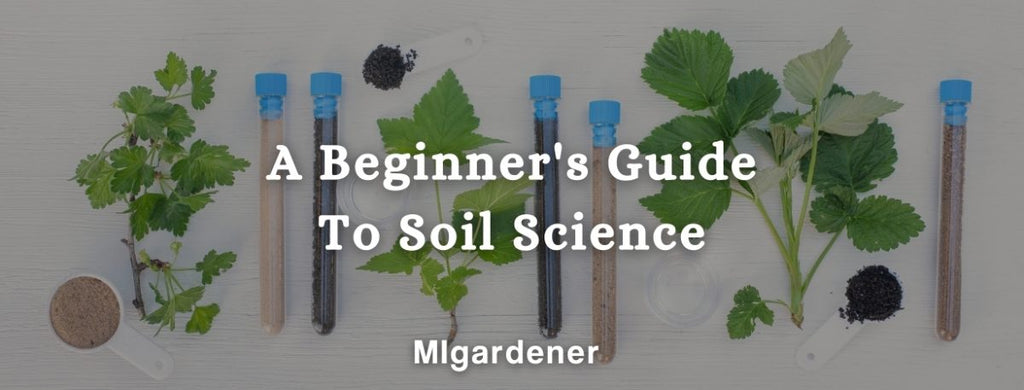
An Beginner's In-Depth Intro To Soil Science
Basic soil science tips are vital for any gardener! Last week we scraped the surface of the importance of healthy soil. We learned that soil and dirt are two opposite things. Now for the big picture. What does healthy soil do for the world besides acting as the medium for all vigorous plant growth? This guide will break down exactly what is needed to create soil that enriches the garden, but also enriches all life on earth!
Let’s dig deep!
Healthy Soil Makeup

Increasing organic matter in our soil helps to absorb and contain carbon from being released back into the atmosphere. The containment of carbon helps to reduce the harmful effects of global climate change. However, organic matter isn't the only ingredient in a healthy garden. Healthy soil needs to contain minerals, air, water, and organic matter. The ideal ingredient percentages consist of 45% mineral, 25 % air, 25% water, and 5% organic.
Microbiological Aspects of Soil
Big and small, aerobic and anaerobic. All components of healthy soil contribute to the physical and chemical make-up are all the reasons we are able to grow healthy and fruitful harvests. Bacteria are single-celled microorganisms that decompose and move organic matter. Some species of bacteria promote healthy plant growth while others may foster disease in plants. Different species of bacteria can live in both aerobic (with oxygen) and anaerobic (without oxygen) conditions.
Similar to bacteria, fungi play a huge part in soil health. Fungi have some similar characteristics to plants but are in a family all of their own. They lack chlorophyll -- the green color in plants that is responsible for photosynthesis. Fungi aid in decomposition. Similar to bacteria there are beneficial and harmful species. A few of the beneficial fungi are:

Mycorrhizal Fungi On Grass Roots
Mycorrhizae- Mycorrhizal fungi that feed off plant roots, more specifically the photosynthates produced by plants creating a network of threads that aid in nutrient uptake and water retention.
Protozoa- single-celled animals act as an aid to the decomposers in the garden
Nematodes- Create more than half of the mineralized nitrogen available. Aid in beautiful foliage growth.
Animals also contribute greatly to the biodiversity of your soil.

Invertebrates- Animals without backbones like worms and centipedes aid in decomposition by consuming plants and animals, and aeration as they work their way through the earth.
Vertebrates- Animals with backbones. These are those animal pests that we all seem to battle. Rodents, groundhogs, and pesky squirrels are in this category.
Physical particle make-up

The mineral makeup (also known as soil texture) of your soil cannot be changed. However, adding amendments can change the overall soil structure. Different plants want a different balance. For instance, carrots and potatoes grow well with a higher sand concentration making it easy for roots and tubers to break through the soil. Brassicas thrive on high nutrients found in clay soils. Silt soils also aid in the growth of shallow-rooted vegetables. Lettuce, onions, and kohlrabi and thrive in soils made up of silt particles.
Sand- unable to retain water, high aeration, because of the high drainage sand particles have a hard time holding on to nutrients as the water washes through
Silt- middle of the ground between sand and clay in all aspects. Aeration, drainage, ability to hold nutrients, water retention.
Clay- poor draining leads to high water capacity, very dense with minimal aeration. Able to hold onto nutrients well.
Loam- A healthy soil structure contains all three components.
Protect the newly cultivated soil health

Building soil structure is a great step in protecting our soil health. Adding organic matter. Limiting tillage. Keeping the soil covered. Be keen as to what we add to our growing medium. Organic doesn't mean healthy. There are many poisonous organic materials in our world that we do not want to come into contact with. There are many steps we can take in our garden before adding external amendments.
Use tools we have talked about in past blogs including intercropping, agroforestry, trap cropping, and mulching just to name a few. When you do have an issue in the garden the first step is to identify the problem. Knowing the pest or ailment that plagues your garden is the first step to combat the problem.
Take Note!
Take a magnifying glass out into your garden and see what you can find. Get your soil tested to find out the breakdown you are working on within your soil. Always take notes during your soil testing process for reference for the future. Each step you take to understanding your garden will be a win for you, your family, and the health of your garden!
– Kaitlynn from MIgardener
Did you enjoy this post? MIgardener is passionate about sharing free gardening tips and information! If you are looking for inspiration in the garden, make sure to check out our Pinterest page. Check us out at MIgardener.com or on youtube, Instagram, and Facebook.

Leave a comment